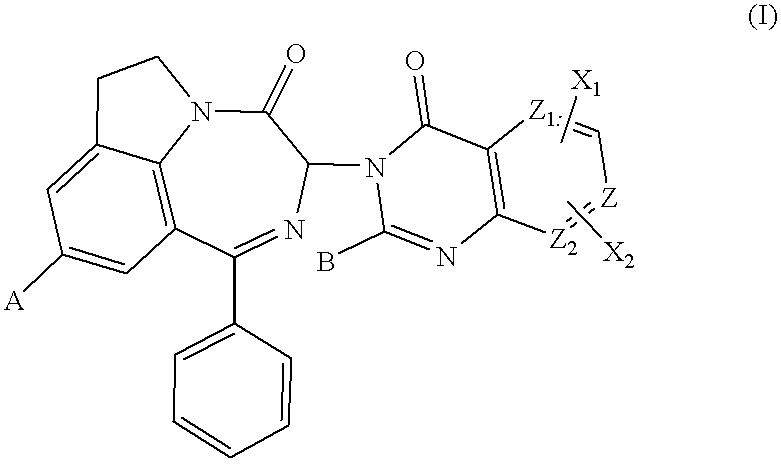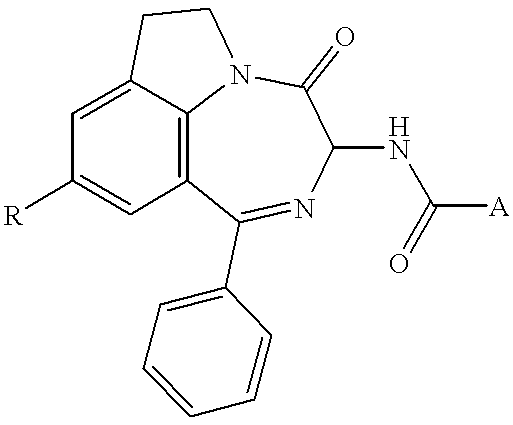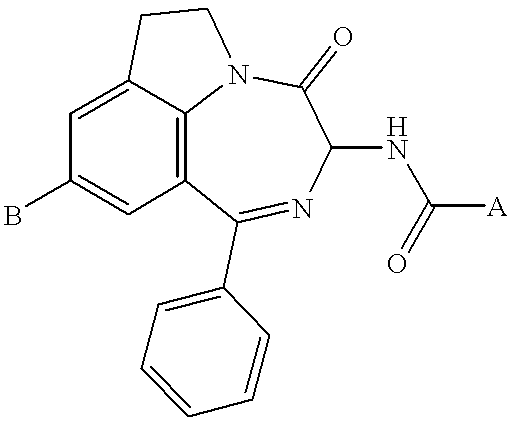Phosphodiesterase 4-inhibiting diazepinoindolones
a technology of phosphodiesterase and diazepinoindolone, which is applied in the direction of biocide, heterocyclic compound active ingredients, drug compositions, etc., can solve the problems of increasing asthma, increasing the risk of cardiovascular disease,
- Summary
- Abstract
- Description
- Claims
- Application Information
AI Technical Summary
Problems solved by technology
Method used
Image
Examples
example 1
(3S)-3-(2-methyl-4-oxo-4H-quinazolin-3-yl)-1-phenyl-6,7-dihydro-3H[1,4]diazepino[6,7,1-hi]indol-4-one.
(I); A.dbd.H, Z.dbd.CH, B.dbd.CH.sub.3, X.sub.1.dbd.H, X.sub.2 .dbd.H (process A1c)
In a reactor protected from moisture, 2.65 g (5.5 mmol) of the intermediate amine 1 of R configuration are dissolved with stirring in 30 ml of CH.sub.2 Cl.sub.2.1.08 g (6.0 mmol) of 2-acetamidobenzoic acid and then 1.8 g (5.5 mmol) of OTUT are added. The mixture is cooled to 0.degree. C. and 1.4 g (11 mmol) of DIEA are then added. After 16 h with stirring at laboratory temperature, the insoluble matter is filtered off and the filtrate extracted successively with IN HCl solution and saturated NaHCO.sub.3 solution and lastly with water. The solvent is evaporated off and the residue purified by flash chromatography on a silica column, eluting with the solvent D / A3. 0.65 g of a crystallized white solid is obtained. Yld=28%--M.p.=210C--TLC (D / M3): Rf=0.26--["].sub.D =+23.6E (c=1, CH.sub.2 Cl.sub.2).
.sup.1 ...
example 2
9-methyl-3-(2-methyl-4-oxo-4H-quinazolin-3-yl)-1-phenyl-6,7-dihydro-3H-[1,4]diazepino [6,7,1-hi] indol-4-one.
(I); A.dbd.CH.sub.3, Z.dbd.CH, B.dbd.CH.sub.3,X.sub.1.dbd.H, X.sub.2.dbd.H (process A1c)
In a 50-ml reactor protected from moisture and under a nitrogen atmosphere, 2.3 g (7.9 mmol) of the intermediate amine 2.a are introduced into 25 ml of CH.sub.2 Cl.sub.2, followed by 1.41 g (7.9 mmol) of 2-acetamidobenzoic acid. The mixture is cooled to 0.degree. C. and 2.24 g (17 mmol) of DIEA are added. The mixture is kept stirring for 1 min at 0.degree. C. and then for 12 h at room temperature, and 2.56 g (7.9 mmol) of OTUT are then added. The mixture is cooled to 0.degree. C. and 2.24 g of DIEA are added. The mixture is maintained for 1 min at 0.degree. C. and then 2 h at room temperature. 2.56 g of OTUT and 2.24 g of DIEA are then added under the same conditions; the mixture is then kept stirring for 48 h at room temperature and thereafter washed with 20 ml of water. The solvent is ev...
example 2a
9-methoxy-3-(2-methyl-4-oxo-4H-quinazolin-3-yl)-1-phenyl-6,7-dihydro-3H-[1,4]diazepino [6,7,1-hi] indol-4-one.
(I); A.dbd.OCH.sub.3, Z.dbd.CH, B.dbd.CH.sub.3, X.sub.1.dbd.H, X.sub.2.dbd.H (process A12c).
0.834 g (4.65 mmol) of acetylanthranilic acid and 1.3 g (4.23 mmol) of 3-amino-9-methoxy-1-phenyl-6,7-dihydro-3H-[1,4]diazepino[6,7,1-hi]indol-4-one are dissolved in 13 ml of CH.sub.2 Cl.sub.2, the mixture is stirred at room temperature and 0.7 g (5 mmol) of phosphorus trichloride is added. The mixture is stirred for 20 h and 0.35 g of phosphorus trichlonrde is added, followed by a fuirther 0.35 g 8 h later. The mixture is cooled, 50 ml of saturated NaHCO.sub.3 solution and 100 ml of CH.sub.2 Cl.sub.2 are added and the organic phase is separated out after settling has taken place and washed with water. This solution is dried, evaporated and purified by chromatography in the mixture DM1. 0.33 g of yellow powder is obtained. M.p.=277.degree. C.--Yld 17%.--TLC (DM3): Rf=0.47.
.sup.1 H NMR...
PUM
| Property | Measurement | Unit |
|---|---|---|
| Fraction | aaaaa | aaaaa |
| Percent by mass | aaaaa | aaaaa |
| Pharmaceutically acceptable | aaaaa | aaaaa |
Abstract
Description
Claims
Application Information
 Login to View More
Login to View More - R&D
- Intellectual Property
- Life Sciences
- Materials
- Tech Scout
- Unparalleled Data Quality
- Higher Quality Content
- 60% Fewer Hallucinations
Browse by: Latest US Patents, China's latest patents, Technical Efficacy Thesaurus, Application Domain, Technology Topic, Popular Technical Reports.
© 2025 PatSnap. All rights reserved.Legal|Privacy policy|Modern Slavery Act Transparency Statement|Sitemap|About US| Contact US: help@patsnap.com



